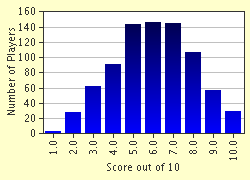Quiz Answer Key and Fun Facts
1. The "axial skeleton" consists of which of the following sections of the body?
2. Which of the following is an example of a "long" bone?
3. What is the main substance (a protein) secreted by the main cells in cartilage that makes up the extra-cellular matrix?
4. What is endochondral ossification?
5. Which of the following is a function of cartilage?
6. Cartilage can grow interstitially or appositionally. What is the principal difference between the two processes?
7. Which of the following bone markings means a hollow passage through a bone?
8. Which options(s) of the following are real types of synovial joint?
9. How does cartilage get its nutrients?
10. Both matured cells of bone and cartilage lie in matrix cavities. What is the real name of these cavities?
Source: Author
iloveruby
This quiz was reviewed by FunTrivia editor
crisw before going online.
Any errors found in FunTrivia content are routinely corrected through our feedback system.


